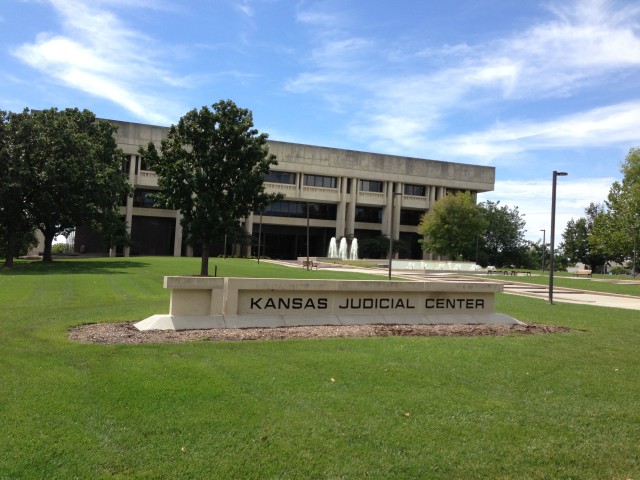The Kansas Supreme Court said Friday the state’s current public school funding levels are unconstitutional.
In the much-anticipated ruling, the court said Kansas’ poor school districts were harmed when the state made the decision to cut certain payments when tax revenues declined during the Great Recession.
The Supreme Court also sent the case back to district court for more review to “promptly” determine what the adequate amount of funding should be, but didn’t set a deadline for a hearing. It did, however, set a July 1 deadline for legislators to restore money for two funds aimed at helping poorer districts with capital improvements and general school operations.
The case has broader implications beyond the classroom: Kansas enacted sweeping cuts to income taxes in 2012 and 2013 championed by Gov. Sam Brownback that have reduced the amount of available resources to comply with a court order.
The lawsuit was filed in 2010 on behalf of parents and school districts who argued the state had harmed students because spending cuts resulted in lower test scores. State attorneys maintained that legislators did their best to minimize cuts to education.
Friday’s decision has been in the works since the state appealed after a three-judge panel in Shawnee County District Court said in January 2013 that the lawsuit was valid. Because no issues involving the U.S. Constitution were raised, there’s no appeal to the U.S. Supreme Court.
In the lawsuit, attorneys representing four school districts and parents alleged that Kansas reneged on promises made in 2006 to provide a certain level of funding the Kansas’ public schools, namely that the failure to provide money for classroom instruction has harmed the state’s education system — including programs aimed at helping poor and minority students.
In recent years, school districts have trimmed their staffs, cut after-school programs and raised fees for parents. Classrooms became more crowded.
State attorneys had said legislators did the best they could to maintain education spending among the reduced available revenues during the recession, pointing to efforts to raise the state sales tax rate in 2010 and the reliance on federal stimulus funding to keep spending stable.
Legislators delayed any decisions on school funding until the high court made a final judgment.
Associated Press Story
—-
—-
The Kansas Supreme Court Friday issued its unanimous opinion in a dispute over K-12 public education financing.
According to a release from the court, justices declared certain school funding laws fail to provide equity in public education as required by the Kansas Constitution and returned the case to Shawnee County District Court to enforce the court’s holdings.
The court further ordered the three-judge panel that presided over the trial of the case to reconsider whether school funding laws provide adequacy in public education – as also required by the constitution.
The plaintiffs in Gannon v. State of Kansas are four public school districts and 31 individuals. Each district lost funding beginning in fiscal year 2009, after the Legislature reduced appropriations for various categories of school funds, including base state aid per pupil, capital outlay state aid, and supplemental general state aid. The plaintiffs claimed continued reductions in school funding violated the education article of the Kansas Constitution—Article 6—which directs the Legislature to “make suitable provision for finance of the educational interests of the state.” The plaintiffs also claimed they were denied equal protection and due process.
The Supreme Court dismissed the individual plaintiffs for lack of legal standing and determined the school districts could not pursue equal protection or due process claims. But the court ruled the districts had standing to bring claims under Article 6 of the Kansas Constitution. The court reasoned the districts sufficiently alleged the funding reductions had undermined their ability to perform the districts’ constitutional duty to “maintain, develop, and operate local public schools.”
The court also rejected the state’s argument that the court had no authority to decide whether the Legislature had underfunded K-12 education because it is strictly a political question, rather than a constitutional mandate. The court ruled that the judiciary has both the duty and the authority to review whether acts of the Legislature comply with constitutional standards. “The judiciary is not at liberty to surrender, ignore, or waive this duty,” the court said.
The court’s decision also clarified that the Kansas Constitution contains at least two separate components for public education: adequacy and equity. The adequacy requirement is met when the structure and implementation of the state’s K-12 public education financing system is “reasonably calculated” to have all students meet or exceed certain minimum educational standards. The court also said the three-judge panel’s test for adequacy was incorrect because it exclusively focused on cost studies. Therefore, the court reversed and remanded the adequacy issue to the panel so it can apply the proper test and make appropriate findings.
Regarding equity, the court said Article 6 does not require absolute funding equality among districts, but it emphasized that “school districts must have reasonably equal access to substantially similar educational opportunity through similar tax effort.” Applying this test, the court concluded the state had established unconstitutional funding disparities among districts when it withheld capital outlay state aid payments and reduced supplemental general state aid payments to which certain districts with less property wealth were otherwise entitled in fiscal years 2010, 2011, and 2012.
The court set a July 1, 2014, deadline to give the Legislature an opportunity to provide for equitable funding for public education. If by then the Legislature fully funds capital outlay state aid and supplemental general state aid as contemplated by present statutes, i.e., without withholding or prorating payments, the panel will not be required to take additional action on those issues. But if the Legislature takes no action by July 1, 2014, or otherwise fails to eliminate the inequity, the panel must take appropriate action to ensure the inequities are cured.
—



